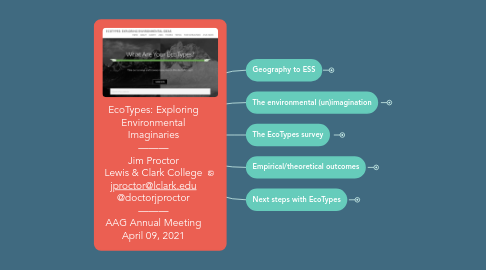EcoTypes: Exploring Environmental Imaginaries ——— Jim Proctor Lewis & Clark College [email protected] @doctorjproctor ——— AAG Annual Meeting April 09, 2021
by Jim Proctor


1. Empirical/theoretical outcomes
1.1. Axis descriptive statistics ( 2019)
1.2. Three EcoTypes themes: Place [green] | Knowledge [blue] | Action [red]
1.2.1. EcoTypes factor analysis results
1.3. EcoTypes themes & paradox "The opposite of a truth is a falsehood. But the opposite of a profound truth is another profound truth." (Niels Bohr)
1.4. EcoTypes and engagement
2. Geography to ESS
2.1. UC Santa Barbara, 1992-2005 Department of Geography Environmental Studies Program
2.1.1. Ideas of nature
2.1.2. Nature, science, religion
2.1.3. Paradox
2.2. Lewis & Clark College, 2005– Environmental Studies Program
2.2.1. ESS curriculum
2.2.2. ESS & place
2.2.3. ESS theory
2.2.4. ESS engagement
3. Next steps with EcoTypes
3.1. Book production/website revisions
3.2. Opening up Big Words in ESS
3.3. Ideas as imaginaries as ideologies
3.4. Theory = engagement = theory
4. The EcoTypes survey
4.1. EcoTypes website
4.2. Fifteen EcoTypes axes: Aesthetics | Change | Diversity | Domain | Ecosystems | Ethics | Future | Nature | Science | Social Scale | Society | Spatial Scale | Technology | Time
4.3. Since January 2017 launch: – ~75 U.S. institutions of higher education – ~5000 survey completions – Primarily undergrads in enviro courses – Predictable demographics (largely white/young/etc.)
4.4. Sample key question/survey items: Nature
4.4.1. Sample distribution of responses: Nature
4.4.2. Sample deep dive: Nature
5. The environmental (un)imagination
5.1. Unimaginative imaginaries: Sustainability
5.1.1. Sustainability and insular utopias
